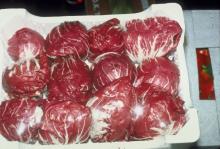Product Description
Maturity and Quality
Maturity is generally based on marketable size after threshold days beyond seed sowing has been reached (commonly 75 to 85 days). Some varieties transition from green to red or red-purple leaves at maturity or the onset of cool weather. Head-forming radicchio are firm and compact at maturity. Leaf raddichio have a long conical shape similar to Romaine lettuce. Radicchio should be harvested with a small stub of root remaining to help retain leaf attachment.
Turgid leaves or firm, compact head with bright appearance typical of variety. Generally, bright white midribs with no cracking or splitting. Absence of marginal leaf necrosis, insect damage, harvest or packaging damage. Absence of bacterial decay at the root end.
Postharvest Handling and Storage
Store at 0°C (32°F). Under these conditions, quality may be retained for 16 to 21 days. Radicchio are generally packed, after thorough precooling, with polymer film liners inside corrugated containers to prevent water loss.
We have recently begun testing the respiration rates of radicchio. For guidance, use the following values:
| 7.5°C (45°F) | 12ml CO2/kg·hr |
| 20°C (68°F) | 25ml CO2/kg·hr |
Exposure to ethylene appears to increase marginal leaf browning and fungal decay. Accelerated pigmentation, pink to purple, of the white midribs occurred after 6 days at 10 ppm C2H4 and 7.5°C (45°F); = 98% R.H.
95% or higher
Low, 0.6 to 1.0 µl C2H4/kg·hr at 20°C (68°F)
The specific responses of radicchio to CA are not well defined at this time. Atmospheres of 3% O2 and 5% CO2 may be beneficial but low temperature is the best method for quality retention. In recent, preliminary, studies low oxygen conditions resulted in internal browning in head radicchio.
Disorders
Radicchio are highly susceptible to Bacterial Soft Rot caused by Erwinia cartotovora at warmer storage temperatures and pectolytic Pseudomonas at lower refrigeration temperatures. Bacterial decay is common when harvesting methods cut across the basal leaves of head radicchio. Leaf margin necrosis and storage decay caused by Botrytis cinerea is also common, even with good temperature management.




